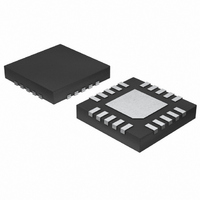MAX8521ETP+ Maxim Integrated Products, MAX8521ETP+ Datasheet - Page 10

MAX8521ETP+
Manufacturer Part Number
MAX8521ETP+
Description
IC DRVR PWR TEC 20-TQFN
Manufacturer
Maxim Integrated Products
Datasheet
1.MAX8521ETP.pdf
(18 pages)
Specifications of MAX8521ETP+
Applications
Thermoelectric Cooler
Voltage - Supply
3 V ~ 5.5 V
Operating Temperature
-40°C ~ 85°C
Mounting Type
Surface Mount
Package / Case
20-TQFN Exposed Pad
Output Voltage Range
- 4.3 V to + 4.3 V
Output Current
1.5 A
Input Voltage Range
3 V to 5.5 V
Input Current
14 mA
Power Dissipation
1.67 W
Operating Temperature Range
- 40 C to + 85 C
Mounting Style
SMD/SMT
Lead Free Status / RoHS Status
Lead free / RoHS Compliant
Current - Supply
-
Lead Free Status / Rohs Status
Lead free / RoHS Compliant
Smallest TEC Power Drivers for Optical
Modules
The MAX8520/MAX8521 TEC drivers consist of two
switching buck regulators that operate together to
directly control the TEC current. This configuration cre-
ates a differential voltage across the TEC, allowing bi-
directional TEC current for controlled cooling and
heating. Controlled cooling and heating allow accurate
TEC temperature control to within 0.01°C. The voltage at
CTLI directly sets the TEC current. An external thermal-
control loop is typically used to drive CTLI. Figures 1
and 2 show examples of the thermal-control-loop circuit.
Switching regulators like those used in the MAX8520/
MAX8521 inherently create ripple voltage on the output.
The dual regulators in the MAX8520/MAX8521 switch
in-phase and provide complementary in-phase duty
cycles so ripple waveforms at the TEC are greatly
reduced. This feature suppresses ripple currents and
electrical noise at the TEC to prevent interference with
the laser diode.
For the MAX8521, FREQ sets the switching frequency
of the internal oscillator. With FREQ = GND, the oscilla-
tor frequency is set to 500kHz. The oscillator frequency
is 1MHz when FREQ = V
For the MAX8520, connect a resistor (R
from FREQ to GND. Choose R
operation, and R
any intermediary frequency between 500kHz and
1MHz, use the following equation to find the value of
R
where R
desired frequency given in MHz. Note that for V
5V, the frequency is reduced slightly, to the extent of
about 7% when V
into consideration when selecting the value for R
known supply voltage.
Both the MAX8520 and MAX8521 provide control of the
maximum differential TEC voltage. Applying a voltage
to MAXV limits the maximum voltage across the TEC.
The voltage at MAXIP and MAXIN sets the maximum
positive and negative current through the TEC. These
current limits can be independently controlled.
10
EXT
______________________________________________________________________________________
value needed for V
EXT
Voltage and Current-Limit Setting
is the resistance given in kΩ, and fs is the
R
EXT
EXT
DD
= 150kΩ for 500KHz operation. For
=
reaches 3V. This should be taken
Detailed Description
90
DD
DD
×
.
⎛
⎜
⎝
= 5V:
Switching Frequency
fs
1
Ripple Cancellation
−
EXT
1
3
⎞
⎟
⎠
= 60kΩ for 1MHz
EXT
in Figure 2)
EXT
DD
at
<
ITEC provides a voltage output proportional to the TEC
current (I
detail:
The MAX8520/MAX8521 include an on-chip voltage ref-
erence. The 1.50V reference is accurate to 1% over
temperature. Bypass REF with 0.1µF to GND. REF can
be used to bias an external thermistor for temperature
sensing as shown in Figures 1 and 2.
The MAX8520/MAX8521 provide fault-current protec-
tion in either FETs by turning off both high-side and
low-side FETs when the peak current exceeds 3A in
either FETs. In addition, thermal-overload protection
limits the total power dissipation in the chip. When the
device’s die junction temperature exceeds +165°C, an
on-chip thermal sensor shuts down the device. The
thermal sensor turns the device on again after the junc-
tion temperature cools down by +15°C.
By design, the MAX8520/MAX8521 are capable of
operating from 0% to 100% duty cycle, allowing both
LX outputs to enter dropout. However, as the LX pulse
width narrows, accurate duty-cycle control becomes
difficult. This can result in a low-frequency noise
appearing at the TEC output (typically in the 20kHz to
50kHz range). While this noise is typically filtered out by
the low thermal-loop bandwidth, for best result, operate
the PWM with a pulse width greater than 200ns. For
500kHz application, the recommended duty-cycle
range is from 10% to 90%. For 1MHz application, it is
from 20% to 80%.
Table 1. TEC Connection for Figure 1
Table 2. TEC Connection for Figure 2
TEC Connection
TEC Connection
Thermal and Fault-Current Protection
Heating Mode
Cooling Mode
Heating Mode
Cooling Mode
TEC
V
ITEC
). See the Functional Diagram for more
= 1.5V +(8
Duty-Cycle Range Selection
Design Procedures
Current Monitor Output
(VOS1-VCS))
Reference Output
Thermistor
Thermistor
NTC
PTC
NTC
PTC











